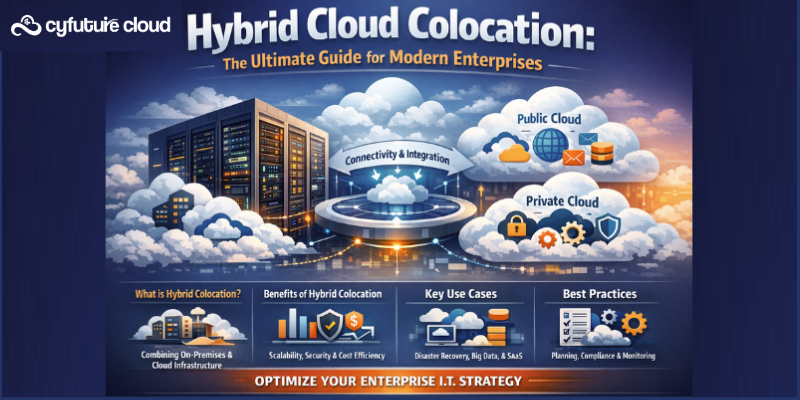Get 69% Off on Cloud Hosting : Claim Your Offer Now!
- Products
-
Compute
Compute
- Predefined TemplatesChoose from a library of predefined templates to deploy virtual machines!
- Custom TemplatesUse Cyfuture Cloud custom templates to create new VMs in a cloud computing environment
- Spot Machines/ Machines on Flex ModelAffordable compute instances suitable for batch jobs and fault-tolerant workloads.
- Shielded ComputingProtect enterprise workloads from threats like remote attacks, privilege escalation, and malicious insiders with Shielded Computing
- GPU CloudGet access to graphics processing units (GPUs) through a Cyfuture cloud infrastructure
- vAppsHost applications and services, or create a test or development environment with Cyfuture Cloud vApps, powered by VMware
- Serverless ComputingNo need to worry about provisioning or managing servers, switch to Serverless Computing with Cyfuture Cloud
- HPCHigh-Performance Computing
- BaremetalBare metal refers to a type of cloud computing service that provides access to dedicated physical servers, rather than virtualized servers.
-
Storage
Storage
- Standard StorageGet access to low-latency access to data and a high level of reliability with Cyfuture Cloud standard storage service
- Nearline StorageStore data at a lower cost without compromising on the level of availability with Nearline
- Coldline StorageStore infrequently used data at low cost with Cyfuture Cloud coldline storage
- Archival StorageStore data in a long-term, durable manner with Cyfuture Cloud archival storage service
-
Database
Database
- MS SQLStore and manage a wide range of applications with Cyfuture Cloud MS SQL
- MariaDBStore and manage data with the cloud with enhanced speed and reliability
- MongoDBNow, store and manage large amounts of data in the cloud with Cyfuture Cloud MongoDB
- Redis CacheStore and retrieve large amounts of data quickly with Cyfuture Cloud Redis Cache
-
Automation
Automation
-
Containers
Containers
- KubernetesNow deploy and manage your applications more efficiently and effectively with the Cyfuture Cloud Kubernetes service
- MicroservicesDesign a cloud application that is multilingual, easily scalable, easy to maintain and deploy, highly available, and minimizes failures using Cyfuture Cloud microservices
-
Operations
Operations
- Real-time Monitoring & Logging ServicesMonitor & track the performance of your applications with real-time monitoring & logging services offered by Cyfuture Cloud
- Infra-maintenance & OptimizationEnsure that your organization is functioning properly with Cyfuture Cloud
- Application Performance ServiceOptimize the performance of your applications over cloud with us
- Database Performance ServiceOptimize the performance of databases over the cloud with us
- Security Managed ServiceProtect your systems and data from security threats with us!
- Back-up As a ServiceStore and manage backups of data in the cloud with Cyfuture Cloud Backup as a Service
- Data Back-up & RestoreStore and manage backups of your data in the cloud with us
- Remote Back-upStore and manage backups in the cloud with remote backup service with Cyfuture Cloud
- Disaster RecoveryStore copies of your data and applications in the cloud and use them to recover in the event of a disaster with the disaster recovery service offered by us
-
Networking
Networking
- Load BalancerEnsure that applications deployed across cloud environments are available, secure, and responsive with an easy, modern approach to load balancing
- Virtual Data CenterNo need to build and maintain a physical data center. It’s time for the virtual data center
- Private LinkPrivate Link is a service offered by Cyfuture Cloud that enables businesses to securely connect their on-premises network to Cyfuture Cloud's network over a private network connection
- Private CircuitGain a high level of security and privacy with private circuits
- VPN GatewaySecurely connect your on-premises network to our network over the internet with VPN Gateway
- CDNGet high availability and performance by distributing the service spatially relative to end users with CDN
-
Media
-
Analytics
Analytics
-
Security
Security
-
Network Firewall
- DNATTranslate destination IP address when connecting from public IP address to a private IP address with DNAT
- SNATWith SNAT, allow traffic from a private network to go to the internet
- WAFProtect your applications from any malicious activity with Cyfuture Cloud WAF service
- DDoSSave your organization from DoSS attacks with Cyfuture Cloud
- IPS/ IDSMonitor and prevent your cloud-based network & infrastructure with IPS/ IDS service by Cyfuture Cloud
- Anti-Virus & Anti-MalwareProtect your cloud-based network & infrastructure with antivirus and antimalware services by Cyfuture Cloud
- Threat EmulationTest the effectiveness of cloud security system with Cyfuture Cloud threat emulation service
- SIEM & SOARMonitor and respond to security threats with SIEM & SOAR services offered by Cyfuture Cloud
- Multi-Factor AuthenticationNow provide an additional layer of security to prevent unauthorized users from accessing your cloud account, even when the password has been stolen!
- SSLSecure data transmission over web browsers with SSL service offered by Cyfuture Cloud
- Threat Detection/ Zero DayThreat detection and zero-day protection are security features that are offered by Cyfuture Cloud as a part of its security offerings
- Vulnerability AssesmentIdentify and analyze vulnerabilities and weaknesses with the Vulnerability Assessment service offered by Cyfuture Cloud
- Penetration TestingIdentify and analyze vulnerabilities and weaknesses with the Penetration Testing service offered by Cyfuture Cloud
- Cloud Key ManagementSecure storage, management, and use of cryptographic keys within a cloud environment with Cloud Key Management
- Cloud Security Posture Management serviceWith Cyfuture Cloud, you get continuous cloud security improvements and adaptations to reduce the chances of successful attacks
- Managed HSMProtect sensitive data and meet regulatory requirements for secure data storage and processing.
- Zero TrustEnsure complete security of network connections and devices over the cloud with Zero Trust Service
- IdentityManage and control access to their network resources and applications for your business with Identity service by Cyfuture Cloud
-
-
Compute
- Solutions
-
Solutions
Solutions
-
 Cloud
Hosting
Cloud
Hosting
-
 VPS
Hosting
VPS
Hosting
-
GPU Cloud
-
 Dedicated
Server
Dedicated
Server
-
 Server
Colocation
Server
Colocation
-
 Backup as a Service
Backup as a Service
-
 CDN
Network
CDN
Network
-
 Window
Cloud Hosting
Window
Cloud Hosting
-
 Linux
Cloud Hosting
Linux
Cloud Hosting
-
Managed Cloud Service
-
Storage as a Service
-
 VMware
Public Cloud
VMware
Public Cloud
-
 Multi-Cloud
Hosting
Multi-Cloud
Hosting
-
 Cloud
Server Hosting
Cloud
Server Hosting
-
 Bare
Metal Server
Bare
Metal Server
-
 Virtual
Machine
Virtual
Machine
-
 Magento
Hosting
Magento
Hosting
-
Remote Backup
-
 DevOps
DevOps
-
 Kubernetes
Kubernetes
-
 Cloud
Storage
Cloud
Storage
-
NVMe Hosting
-
 DR
as s Service
DR
as s Service
-
-
Solutions
- Marketplace
- Pricing
- Resources
- Resources
-
By Product
Use Cases
-
By Industry
- Company
-
Company
Company
-
Company
How Beneficial is the Public Cloud to Businesses?
Table of Contents
Efficiency. Agility. Doing more with less. Moving to the cloud makes sound financial sense in the modern era of rapid change. It is a quick-moving digital economy and ongoing innovation. Thanks to cloud computing, business owners can focus on what’s most important: their company.
Businesses can establish their cloud strategy using public, private, or hybrid clouds. The selection is influenced by several variables, including the type of business application, the associated costs, technical expertise, and other commercial parameters. This blog will discuss the public cloud and its advantages for businesses in more detail.
First, let’s understand what a public cloud deployment model is.
The public cloud is the most typical kind. Cloud service providers connect organizations to resources like infrastructure, storage, and servers over the Internet. On the other hand, the shared physical equipment is owned and operated by third parties, who offer it to companies depending on their needs. Amazon Elastic Compute Cloud (EC2), IBM’s Blue Cloud, Google AppEngine, Sun Cloud, and Microsoft Azure are popular public cloud services. In the public cloud, numerous businesses share the physical hardware.
Furthermore, thanks to the multi-tenant architecture, it is simple to share infrastructure costs among several users. The public cloud is cost-effective and a pay-as-you-model, so it is ideal for SMBs. The public cloud typically offers many non-sensitive, traffic-heavy online applications that are accessible to the general public. We discuss the implications of public cloud adoption and its impact on business growth and scalability.
Benefits of Public Cloud Deployment Model to Businesses
In this section, we have highlighted a few of the public cloud deployment model’s top advantages for businesses. Let’s examine them.
1. Cost-Effective:
The public cloud’s very adaptable pricing model is one of its biggest benefits. Most public cloud service providers let businesses pay by the hour. Consequently, it makes it possible for businesses, especially small and medium-sized ones, to keep costs to a minimum by only investing in infrastructure when it is necessary. Online applications can be used by businesses without paying recurring expenses for servers, software, setup, or maintenance.
2. Quickly Set Up:
In a couple of hours, businesses may be using the public cloud. Although it is easily ordered online, deployed, and configured remotely using the website of the cloud provider. Your IT personnel can rapidly set up and maintain the setup remotely with just an internet connection.
3. Staffing Budget Optimization:
Top-notch IT professionals are expensive and hard to come by, the personnel budget frequently makes up more than half of the overall computing expenses. Companies using the public cloud only need to pay for the cloud services they need. Since cloud management is so easy, they can always reorganize their IT teams and deploy qualified personnel which will benefit the company’s bottom line.
4. No Maintenance is Required:
The gear, software, and networks that make up the cloud must be maintained by the cloud provider. Therefore, businesses are no longer required to worry about security updates and maintaining their infrastructure current. It allows them to manage the infrastructure with a little IT staff, thus reducing overall costs.
5. No Long-Term Contracts:
Since they frequently are unaware of the actual requirements, small and medium-sized businesses typically do not want to sign long-term contracts or commit to a specified storage or bandwidth capacity. Public cloud hosting is the best option in these circumstances because it does not call for a substantial outlay of money or time.
6. Maximum Uptime and No Chance of Failure:
Nearly all public cloud providers advertise a failure risk of 0% and an uptime of better than 99%. The entire cloud system links several servers, if one fails, the workload is immediately transferred to the other. It guarantees continuous and uninterrupted performance for applications that are essential to the operation of the business.
The term “cloud computing“ is no longer only a fad. SMBs all around the world rely on it since it is a tried-and-true solution. The best choices for cloud implementation are often web-based, customer-facing applications that many users must access from several places.
7. High Flexibility and Lack of Redundancy:
Before the cloud, businesses had to invest in extra hardware, storage, and software to be prepared for failure. To maintain corporate continuity, they must often duplicate their efforts and expenditures. The cloud relieves businesses of the burden of data backup and associated expenditures by automatically duplicating data across data centers located throughout the globe.
Final Thought:
In the digitalization era, where everything is rapidly changing, moving to the cloud is the best financial sense. Now, business owners are more focused on what is important for their business growth. To establish the cloud strategy, there is a public, private, and hybrid clouds that you can choose from.
Well, the public cloud is one of the most typical clouds. It means the service providers share the resources over the internet. The shared physical resources are provided by a third party, according to the business requirements. The public cloud offers various advantages to businesses that lead the business top in the market.
Recent Post

Stay Ahead of the Curve.
Join the Cloud Movement, today!
© Cyfuture, All rights reserved.
Send this to a friend

 Pricing
Calculator
Pricing
Calculator
 Power
Power
 Utilities
Utilities VMware
Private Cloud
VMware
Private Cloud VMware
on AWS
VMware
on AWS VMware
on Azure
VMware
on Azure Service
Level Agreement
Service
Level Agreement 


















